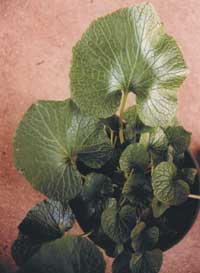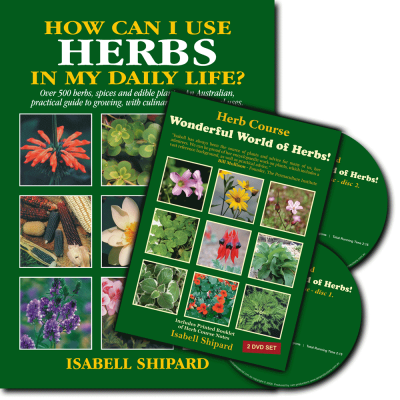Japanese Horseradish, Namida, Bergstockrose
Wasabi japonica syn. W. pungens, Cochlearia wasabi, Alliaria
wasabi, Eutrema wasabi F. Brassicaceae
Description
Perennial, endemic to Japan, growing naturally beside mountain streams, to 30cm high, with glossy, dark-green, kidney-shaped leaves to 15cm long and 15cm wide. Leaves form on thick stemmed petioles and stand upright, from the base of the plant. Racemes of small, white flowers are followed by twisted capsules, containing several small seeds.
… … omitted text, please see How can I use HERBS in my daily life? for full text.

Medicinal Uses
The whole plant is used: leaves, stems and rhizomes. The rhizomes have a strong penetrating odour, which can clear the head and bring tears to the eyes, when smelt or ingested. The flavour is fiery, sharp and pungent, similar to Horseradish (Armoracia rusticana) which also belongs to the Brassicaceae family (see p 163). Wasabi is valuable medicinally for its antibacterial properties, anti-inflammatory action used for coughs, colds and sinusitis, and for diarrhea, as well as for it’s ability to stimulate the appetite and remove toxins from the body. Scientists have recently found that a component of the plant inhibits the formation of blood clots and cerebral thrombosis.
Research at the Japanese Institute for the Control of Ageing, found that wasabi contains substances that suppress the growth of human stomach cancer cells. Wasabi is a powerful digestive stimulant. It has also been used as an antidote to fish poisoning. The plant has exhibited strong antioxidant properties, with fifteen powerful hydroxyl radical scavenging agents identified.
Culinary Uses
As well as providing health benefits, wasabi can play an important role in flavouring foods. As a traditional Japanese flavouring dating back to the 10th Century, wasabi is a condiment customarily served with sushi and sashimi. Wasabi’s flavour compliments soups, noodles, rice dishes, grilled and barbecued meats and fish. In the days before refrigeration, wasabi was added to foods to kill bacteria and disguise unpleasant tastes.
The flavour is so intense, only a little is required to give ‘zing’ to a dish. Wasabi is a flavour that can become a passion. As one wasabi lover said, “What makes people passionate about wasabi is the anticipation of the piercing pain in the head.”
… … omitted text, please see How can I use HERBS in my daily life? for full text.
If you relish fiery flavourings, you will find wasabi absolutely fabulous. The pungency will thrill the tastebuds, clear the nasal passages, bring tears to the eyes, provide pain like a rocket taking off, and give you an endorphin high. Just remember, use it sparingly, or the sensation might be more than you anticipated.


